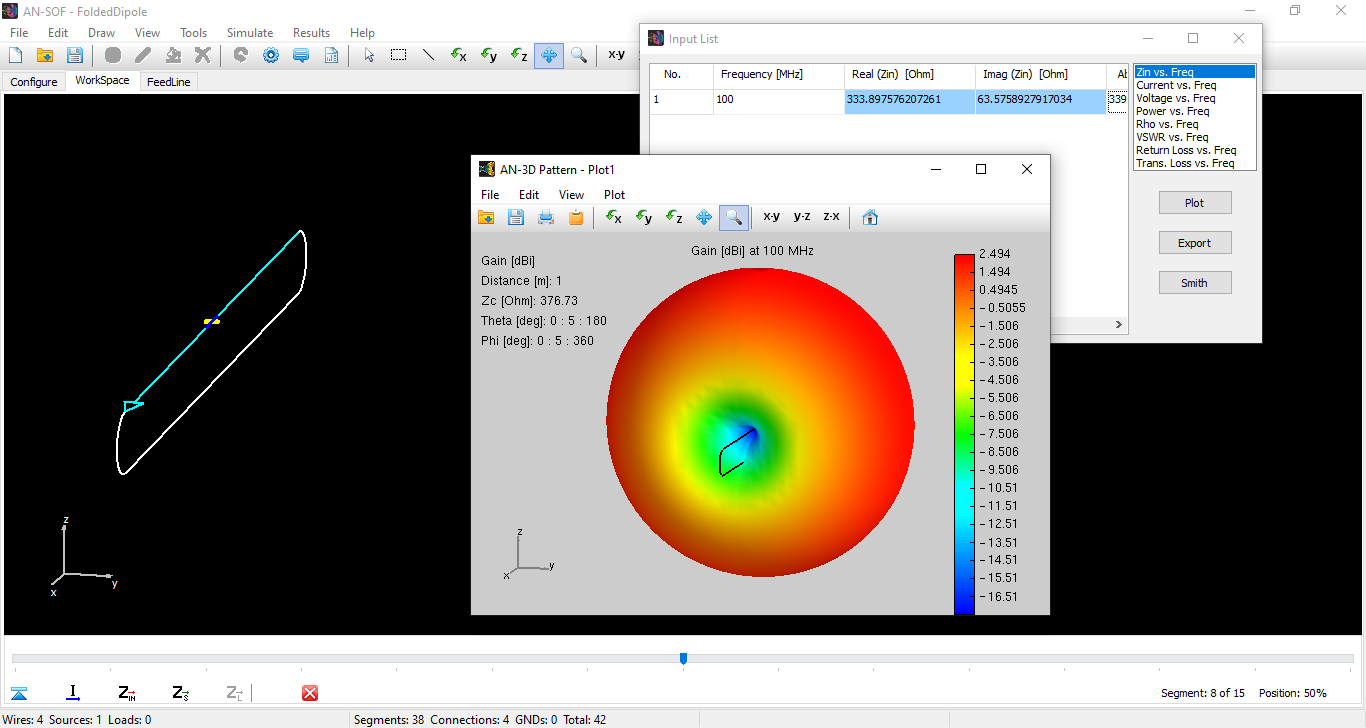Search for answers or browse our Knowledge Base.
Guides | Models | Validation | Blog
Understanding the Folded Dipole: Structure, Impedance, and Simulation
Explore the fundamentals of folded dipole antennas. Learn how accurate simulations using conformal modeling in AN-SOF reveal the true behavior of curved wire geometries and confirm the expected input impedance.
Basic Structure
A folded dipole is a variation of the classic half-wave dipole antenna, designed to offer a higher input impedance and broader bandwidth. It is commonly used in television antennas, FM broadcasting, and other VHF/UHF applications.
A folded dipole consists of two parallel conductors of equal length, spaced closely apart, and connected at both ends. One of these conductors is center-fed, while the other forms a closed loop. Both conductors are typically of equal diameter and length (Fig. 1).

- Length (L): Total length of the antenna is approximately λ/2.
- Spacing (d): Relatively small compared to the wavelength (λ).
Operating Principle
The folded dipole operates on the same resonance principle as a standard half-wave dipole, but due to its geometry, it modifies the current distribution and input impedance. The presence of the second conductor “folds” the current path and causes a redistribution of voltage and current.
Impedance of a Folded Dipole
The main reason for using a folded dipole is its higher input impedance compared to a standard dipole.
If both conductors have equal diameter and are closely spaced, the input impedance of a folded dipole is:
$\displaystyle Z_{in} \,=\, 4 \times Z_{dipole} \,\approx\, 4 \times 73 \, \Omega \,=\, 292 \, \Omega$
This makes it a good match for 300 Ω twin-lead transmission lines.
We must point out that 73 Ω is the real part of the input impedance (radiation resistance) of an infinitesimally thin, center-fed λ/2 dipole in free space. In practice, finite conductor thickness increases the radiation resistance. To accurately account for this effect, it is important to run a simulation using a solver that implements the Exact Kernel of the integral equation—as is done in the AN-SOF software.
Radiation Pattern
- Similar to a standard dipole.
- Broadside pattern (maximum radiation perpendicular to the axis).
- Omnidirectional in the horizontal plane when mounted vertically.
Advantages
- Higher input impedance (easier matching to 300 Ω lines).
- Broader bandwidth compared to a simple dipole.
- More robust mechanical structure due to the loop design.
Considerations
- Needs to be properly matched if used with 50 Ω or 75 Ω coaxial cables (often a balun or impedance matching transformer is used).
- Performance depends on conductor spacing and diameter.
Simulation of a Folded Dipole with Curved Wires
This simulation models a folded dipole antenna using curved wire segments at the ends, accurately represented using conformal segments (Fig. 2). Unlike the traditional Method of Moments (MoM), which approximates curved wires with straight segments, AN-SOF employs the Conformal Method of Moments (CMoM) to precisely model the geometry.

The resulting radiation pattern exhibits the standard donut-shaped form expected from a half-wave dipole, with only minimal distortion. Folded dipoles are commonly used to increase the radiation resistance of a standard half-wave dipole (typically around 75 Ω). In this simulation, the folded dipole shows an input impedance with a real part close to 300 Ω, consistent with theoretical expectations.
We encourage users to explore the sensitivity of the folded dipole’s input impedance by experimenting with different conductor radii and adjusting the radius of curvature at the wire ends. The latter can be modified by changing the geometry of the arcs at the dipole ends.

